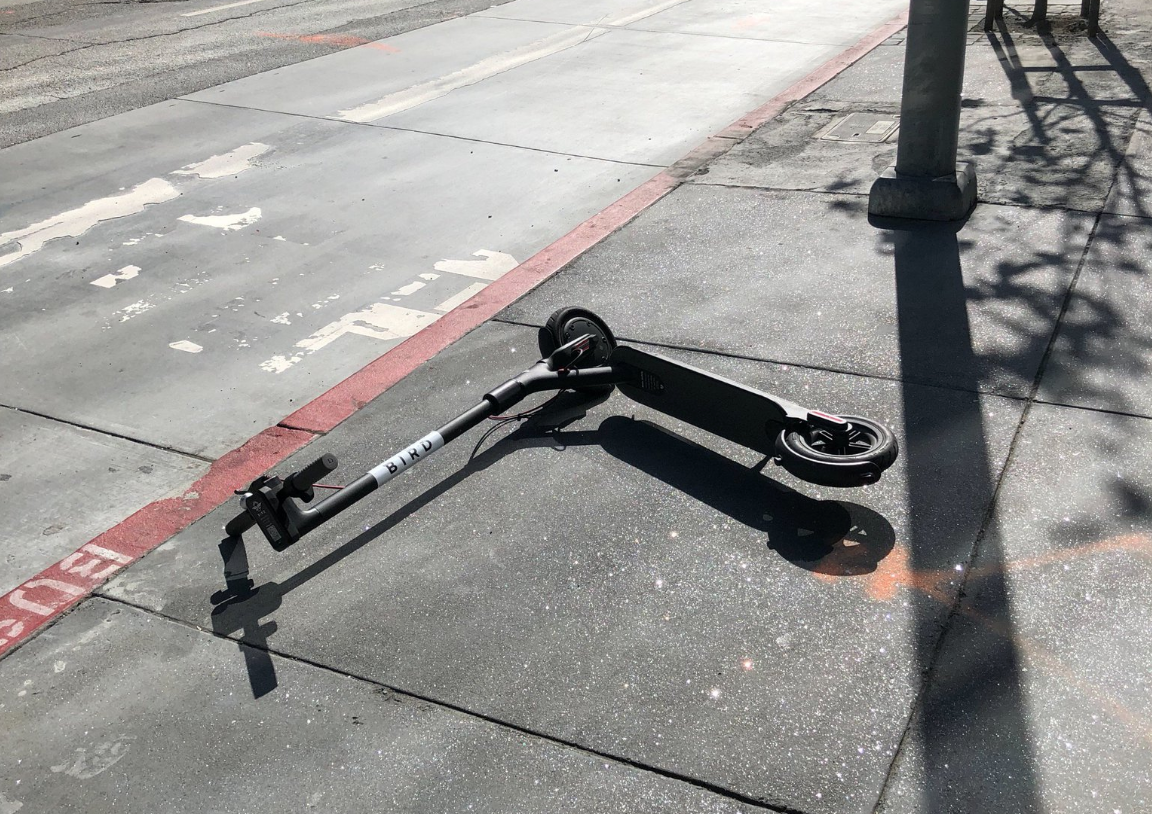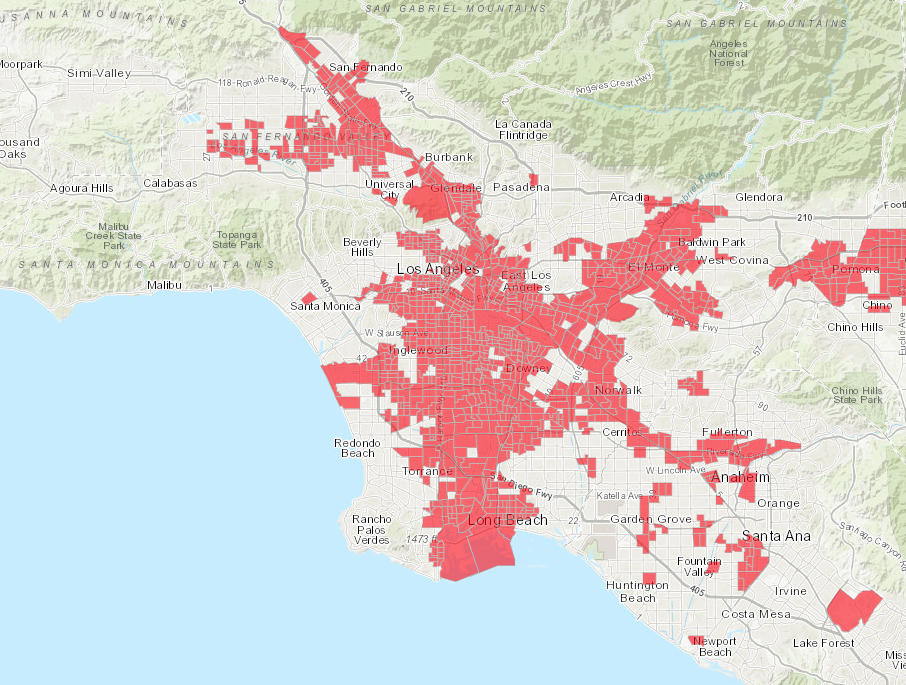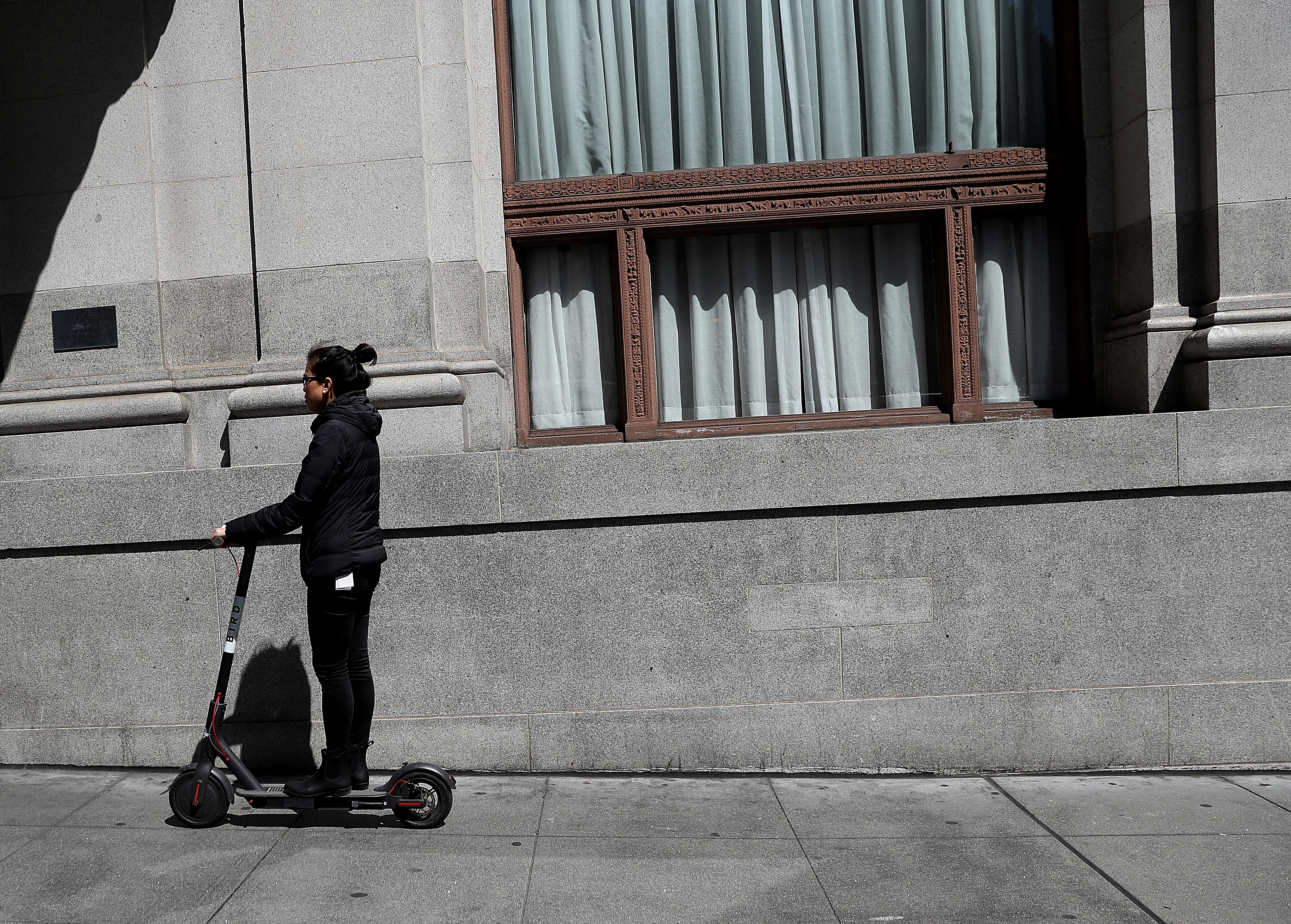Cities all over the world have seen an influx of two-wheeled, electric kick scooters on the road over the last couple of years. Scooters from the likes of Bird, Lime, Spin, Uber’s JUMP, Lyft and others are all trying to own the first and the last mile. The first mile is often understood as the distance between a transportation hub and someone’s starting point while the last mile is the distance between a transportation hub and someone’s final destination. These companies want both, and some (Uber, Lyft) also want everything in between.
The rise of electric scooters is often compared to the rise of ride-hailing, but there are some key differences at play. For one, cities are in charge of regulation — not the states. And since these are much smaller vehicles, cities can easily pick them up and throw them in the back of a truck if they become a nuisance. Meanwhile, as part of city regulation, data-sharing is not optional — it’s a requirement in order for companies to receive permission to deploy scooters on city streets.
The startup ecosystem had become accustomed to the ethos of begging for forgiveness, rather than asking for permission. But that’s not the case with electric scooters. These companies have found their entire businesses to be contingent on the continued approval from individual cities all over the world. That inherently creates a number of potential conflicts.
It’s also unclear whether the increase in people riding scooters is indicative of people adopting shared services or simply adopting a new mode of transportation. Some industry insiders wonder if it’s just a matter of time between consumers ditch shared scooters in exchange for their own.
Between city regulators capping the growth of operators, the vast number of companies going after the first and last miles and the threat of the shift from shared to ownership, it’s all going to come down to the survival of the fittest.
At the mercy of cities
Unlike the ride-sharing market, electric scooter operators are entirely dependent upon cities. These cities, rightfully so, have a number of concerns ranging from safety to sidewalk congestion to equal access to transportation.

In Los Angeles, nearly 250 people went to the emergency room for scooter-related injuries in 2018, according to a study from the University of California Los Angeles. In San Francisco, the city responded to an early influx of scooters by impounding some of them. In one week last April, the SF Department of Public Works impounded 319 scooters, which resulted in fees of $5,774 for Bird, Lime and Spin.
“Everything from the fact that a city can roll up in a truck and put all of your assets away is a totally different process,” Bain Capital Ventures Partner Sarah Smith told TechCrunch. “So you have to take a collaborative approach with the city. Cities will determine how many scooters are on their roads.”
What also makes it difficult for operators is that each city has its own regulations. What’s acceptable in San Francisco may not fly in Austin, for example.
“There’s a lot of bureaucracy,” Michal Naka, co-founder of micromobility data solutions for cities, told TechCrunch. “There’s not a whole lot of consistency across cities and municipalities. You have all of these employees who are suddenly managing these multi-billion-dollar companies on their streets. It’s not easy to integrate all of these operators. It’s a lot to manage.”
There are three ways cities can regulate scooters. There could be no caps and fixed caps, “which is bad because then there’s not enough scooters on the road.” Then, there’s dynamic capping.
“Dynamic capping is key,” Smith said. “We think most cities will implement dynamic capping.”
Instead of a hard and fast rule on the number of scooters allowed on the roads at any given time, some are proposing dynamic capping. Dynamic, data-driven capping would inform cities about real-time usage and enable operators to deploy or remove scooters from certain areas depending on current demand.
A city, for example, could say operators could have as many scooters as they want, as long as each scooter completes a certain number of trips per day.
“Part of the challenge right now is a lot of the cities are still technologically behind in terms of data,” Smith said.
In San Francisco, for example, there’s a cap of 625 scooters for each company. Given the city allowed just two companies, Skip and Scoot to operate, that comes out to just 1,250 scooters. And, as the city approaches its six-month point in the pilot, it’s thinking about how it wants to proceed for the next six months and beyond. According to the terms of the program, Skip and Scoot may each be allowed to deploy an additional 1,875 scooters. Or, the city could decide to allow other operators, such as Lime, Uber’s JUMP and Lyft to deploy their own fleets.
Earlier this year, the San Francisco Municipal Transportation Agency denied the respective appeals of Spin, Lime and JUMP to operate in the city. Still, it’s possible the Agency may grant them permits for part two of the pilot program.
“We’re still fleshing it out based on data,” SFMTA Director of Sustainable Streets Tom Maguire told TechCrunch. “What we really see for the pilot is the place to prove out all of the issues around access, safety and accountability. And we certainly do have options to increase the number of scooters or add other operators.”
In October, when the SFMTA hits the one-year mark, that’s when the agency will need to decide if scooters will have a permanent place in the city.
“We haven’t decided yet exactly what we’ll do,” Maguire said. “I think they have a lot of promise to fill in some of the gaps in our transportation system — providing last mile options to and from the bus stop. It’s clear that as long as they can be operated safely, that they’re a good alternative to getting around. If we can get things right, they absolutely have a role.”
Over in Austin, San Antonio and San Diego, they give operators a lot more flexibility and the ability to deploy more scooters.
“In terms of regulation, you have SF, which has some of the strongest regulation,” Naka said. “Then there’s Oakland, which has taken a more relaxed approach in not capping vehicles. They also don’t have high fees. There’s a stark contrast of how cities can make and break these programs.”
Austin, according to Naka, is leading in terms of scooter regulation and policy. Austin currently allows ten companies to operate shared electric scooters in the city. That includes the likes of Bird, JUMP, Lime, Lyft, Spin, Skip and Razor. Bird, for example, is allowed to operate 1,000 scooters within downtown Austin, and 4,000 outside of the downtown area.
“I think [Austin is] a place a lot of other cities are looking to for regulation,” he said.
Meanwhile, in Santa Monica, the city has implemented dynamic capping. That means operators must meet a minimum number of trips per day per vehicle in order to be able to deploy more vehicles.
This system, which is part of the city’s 16-month pilot program, enables operators to have a minimum of 250 scooters deployed at any one time, with the option to deploy more in order to meet demand. The pilot program, which includes Bird, Jump, Lime and Lyft, ends in January 2020.
In Paris, where there are currently nine scooter operators, the city allows operators to deploy as many scooters at they want. But there’s a catch. In March, the city announced operators of free-floating mobility services will have to pay a tax depending on the size of their fleets. If this plan goes into effect, scooter companies will need to pay €50 per scooter per year. The tax is designed to hold companies more accountable and ensure they properly maintain their fleets.
Another concern of many cities is equal access to transportation across neighborhoods, race and income. In Los Angeles, the city requires scooter companies to offer low-income fare options, a cash payment option as well as an option that does not require a smartphone. Companies are also allowed to deploy additional scooters in disadvantaged communities.
As determined by the California Office of Environmental Health Hazard Assessment, disadvantaged communities entail places with socioeconomic disparities, as well as those that are disproportionately impacted by environmental pollution and public health effects. Below, you can see which areas (marked in red) in Los Angeles are considered disadvantaged communities.

In these areas, electric scooter companies are allowed to deploy 2,500 additional scooters and 5,000 additional scooters in the San Fernando Valley. This is on top of the 3,000 scooters per company cap.
On the side of companies, some have launched low-income programs to increase access to transportation. Lime has Lime Access to enable people who qualify for state or federal assistance programs to access its fleet of vehicles at a discount. Bird also has One Bird, which eliminates the $1 fee to unlock the scooters.
In order for electric scooter operators to thrive in cities, they’re going to need to continue working in partnership local regulators. That means a continued willingness to follow the rules, encourage safe behavior among its riders and share data.
D.R.E.A.M.
Data rules everything around me (D.R.E.A.M.). Cities are relatively down for this new era of transportation and operators are increasingly more willing to share their data with cities. Now, cities just have to find out what to do with this data and how to extract learnings from it.
“We’re able to share more data with those companies which I think is really helpful for policymaking and decision-making but it also helps us to set up rules of the road that meet the needs of everybody in San Francisco,” Maguire said.
A number of startups have emerged in this space, including Populus, Passport and Ride Report. Populus, which in March raised a $3.1 million seed round from Precursor Ventures, Relay Ventures and others, helps cities make sense of the influx of transportation data. The platform is designed to enable cities to access vehicle and trip data from shared-mobility operators. City planners can view where people park and ride scooters, for example, to better determine the best place to put scooter parking areas and dedicated lanes.
Populus currently works with Washington, D.C., and cities in the SF Bay Area and Los Angeles regions. Given that most cities require shared-transportation operators to share data with them, it’s easy for Populus to come in as a third party. Populus also offers real-time data from rideshare companies to inform curbside management and pricing.
Populus works by having cities and operators purchase the platform on a subscription basis. Populus then securely ingests and hosts the data, and proceeds to offer tools to cities and operators to better understand how residents are using the transportation services in the city.
There’s also Passport, which recently partnered with Charlotte, N.C., Detroit, Mich. and Omaha, Neb. to create a framework to apply parking principles, data analysis and more to the plethora of shared micromobility services.
“For many cities, the only option has been to impose bans, fees or permit systems intended to cap the number of scooters allowed on their streets,” Passport CEO Bob Youakim told TechCrunch via email at the time. “While this allows cities to temporarily control scooter deployment, there are greater benefits to achieve by aligning with new mobility providers.”

With Passport, those cities will be able to easily analyze scooter usage, parking patterns and curb utilization. Passport also enables cities to implement real-time curbside pricing and payments and better manage scooter placement. The idea is that cities and mobility providers will work better together if there are economic incentives in place.
Over in Portland, Naka and his colleagues at Ride Report analyzed stress levels among cyclists before and after proper infrastructure was in place.
“We detected change in comfort and stress level before and after proper protected infrastructure were put in place,” Naka said. “Planners for years have been wanting to put investment dollars into bike lanes but it’s hard to come by.”
Ride Report’s analysis was able to help the city make the case for more protected infrastructure. Just about every city wants this data and needs it in order to make informed decisions about how, where and when to deploy scooters. For the long-term success of micromobility, cities ultimately need to ensure they are built with micromobility in mind.
That means having dedicated micromobility lanes, but, unfortunately, the pace of cities “can’t match the speed of what these operators and tech companies can produce,” Naka said. “That inherently causes a conflict.”
Up and to the right
A driving factor for investors is the sheer size of the market. By 2030, the market size for electric scooters is expected to hit $41.98 billion, according to Grand View Research.
“Rising consumer awareness about eco-friendly transportation, increasing adoption of electric scooter sharing services, and declining raw material prices are expected to fuel the demand,” the firm wrote in its February report. “Growing focus on sustainable transportation infrastructure is also projected to augment the market growth. Manufacturers are adopting various strategies, such as collaborations, mergers, and product launches, to enter the continuously evolving electric scooters industry.”
Another study, created by scooter manufacturer Unagi and UC Berkeley Haas School of Business, found electric scooters will represent annual average revenues of up to $42 billion by 2025.
Traction (ridership), of course, has also been a key driver for venture excitement around shared electric scooters. In September, Bird hit 10 million scooter rides its first year of operations. At the time, Bird counted over two million unique riders. Bird competitor Lime, that same month, announced it surpassed 11.5 million rides across its shared bikes and scooters.
But while ridership is growing, unit economics are struggling. Scooters don’t last long. Period. Wear and tear is a major issue in the realm of electric scooters, resulting in a short lifespan of individual scooters and poor unit economics. Some scooters reportedly only last about two months, which is not enough time to recoup the cost of purchasing the scooter.
More recently, operators like Bird and Skip have spoken more publicly about the rough reality of unit economics.
“When I think about opportunities to figure out our unit economics,” Shalin Mantri, head of product at Skip, told TechCrunch a few months ago, “it’s no secret now — it was probably a dirty secret of the industry, you know, a few months ago — that it’s hard to make money, and some of the biggest challenges to doing that are the cost of charging, the lifetime of the battery, the repair costs, the depreciation of these things being used in a fleet use case and the last is vandalism and theft, which is another big issue.”
Over in Louisville, Kentucky, it seems that the average lifespan of a Bird scooter is just 28.8 days, according to a Quartz analysis. Still, investors are pouring money into these companies.
Both Lime and Bird are currently valued north of $2 billion, and Ford bought Spin for $300 million.
“It’s very hard to ignore the rate of change in terms of growth,” Shaun Abrahamson, managing partner at city and mobility-focused VC fund Urban.us told TechCrunch. “No one was riding scooters and then month over month, there was crazy growth. I think historically that’s proved to be a really sound and rational investment decision driver. I think as a rational investor at growth stage, it makes a lot of sense.”
Another pro for investors is that these scooters operate as mini billboards, Smith (investor in Lime) said.
“It’s customer acquisition on wheels,” Smith said. “They don’t have to pay for online ads. You could almost attribute some of the costs of these vehicles to marketing.”
But for other firms, investing in electric scooters feels risky.
“For us, looking at earlier stage, it sounds much more uncertain,” Abrahamson said. “We like traction but sometimes traction is a local optimum. The S-curve ends faster than people expect.”
There seems to be very little indication that people want to stop owning stuff, Abrahamson said. Granted, he admits that he’s biased given the data points he’s seen from companies building their own vehicles. Urban.us invests in Future Motion, the maker behind the company that creates the OneWheel.
“What we may be doing is teaching people to get out of the car and do something else, but maybe this is traction showing that people are changing their lifestyles versus adopting this specific new mode of transportation,” he said.
Personal ownership

What’s not clear at this point in the early days of micromobility is if people are adopting the shared model or simply just adopting new forms of transportation. This is where the question of shared versus ownership comes in.
“Do you get your own one of these things — a board, scooter, bike — or do you just assume super high availability and find that more convenient? Buried in that are a lot of other things,” Abrahamson said. “People have vehicles as sort of a fashion accessory. Maybe you want to tweak it for more performance. Having what is effectively a fleet vehicle, which will be more optimized for ruggedness, is not optimized for performance. It’s not an extension of self-expression.”
Already, some companies are making early bets on the ownership model. Unlike the other electric scooter startups that have cropped up over the past year, Unagi is taking a different approach. David Hyman, founder of Unagi, is betting that after people become accustomed to riding electric scooters via the likes of Bird, Lime, Spin, Skip and so forth, they’ll realize it’s cheaper to just buy their own. At the time of launch, Hyman admittedly said he had no data to back up the hypothesis but that he was working to figure that out.
Fast forward to today, and Unagi has determined, in partnership with the U.C. Berkeley Haas School of Business that 35 percent of scooter riders will prefer to own versus rent. That would result in up to $12 billion in annual revenue by 2025, according to the study.
Personal ownership also means companies don’t need to worry about city regulators and bending to their whims.
There is also, of course, Xiaomi and Segway-Ninebot, which supply many of the scooters we see on the roads today. These companies not only sell to service providers but also directly to consumers.
Here’s a quick back of napkin scenario from Castro Street underground train station in San Francisco to TechCrunch’s office. This is to determine the cost comparison between using an electric scooter as a primary mode of transportation while renting versus owning.
Today, you can buy your own electric scooter ranging from $199 to $890. Meanwhile, scooter share service Skip, based in San Francisco, costs $1 to unlock plus $0.25 a minute.
According to Google Maps, it takes about 18 minutes to bike 2.5 miles. For the purpose of this scenario, we’re just going to assume it takes about the same amount of time — give or take a few minutes — to get there on an electric scooter while obeying traffic laws. So, let’s say it takes 14 minutes to get there on an electric scooter.
To rent an electric scooter twice a day, five days a week for one year, that comes out to $45 per week, or, $2,340 per year. If you want to ride on weekends or more than twice a day, that cost increases. Meanwhile, even buying the most expensive scooter at $890 would pay for itself in about four months.
Now, this math does not take into account the energy costs of charging the scooter, as well as any costs of maintenance. Though, there is a such a thing as product warranties.
Survival of the fittest
Despite the ownership versus shared model debate, it comes down to which companies make the best products. Otherwise, there are only a couple of options: sell or die.
Already, consolidation has hit Latin America and it’s happening very quickly. Grow (formerly known as Grin), the Mexico City-based electric scooter company backed by Y Combinator, merged with São Paulo-based Ride to further the company’s expansion across Latin America. That came shortly after Grin raised a ~$45 million Series A round. A few months after Grin merged its electric scooter business with Brazil-based Ride, it merged with Yellow, the bike-share startup based in Brazil that has also expressed its ambitions to get into electric scooters.
Grin had many of the characteristics VC firm Base10 was looking for, Base10 Managing Partner Adeyemi Ajao told TechCrunch. The company already operated in a densely-populated city with infrastructure that enables frequent usage of electric scooters, had a local team working well with regulators and was able to secure a good supply of scooters.
“We remain bullish on the combined company and believe they can become the dominant micro-mobility company in Latin America,” Ajao said.
Given the state of electric scooters in Latin America, Naka believes there will be a lot more consolidation.
“I think Latin America provides a great example,” Naka said. “It’s just one big super company now.”
In Europe, especially, Naka sees there being a lot of consolidation. Regulation, of course, may have a big effect on consolidation.
“In a lot of ways, there are competitive advantages with permitting,” Naka said.
If Grow, for example, wants to get into the North America market, it’s probably going to look for the companies that have permits in the most attractive markets.
“It’s going to have to happen,” he said. “Madrid has permitted 18 different companies, which is from a user perspective, insane to have so many to choose from.”
The years ahead

As Naka said, expect more consolidation. It’s worth noting both Uber and Lyft reportedly had their eyes on Bird while Ford has already snapped up Spin. Given the sheer number of electric scooter operators that have sought permits in the U.S. (more than 10), there’s room for some consolidation.
“I definitely see Uber and Lyft — the big ride-hail companies — play a part in the consolidation moving forward,” Naka said.
Cities, especially in the U.S., will also need to put proper infrastructure is in place. That could entail adding more bike and dedicated micromobility lanes, decreasing the number of parking spot minimums, converting car parking spaces into dockless parking spaces.
And, to increase the availability of scooters, Naka envisions restaurants or other points of interest offering vending machines for swappable batteries. Retailers and local businesses could pay companies to put charging vending machines on their property to help them drive new business.































Comment